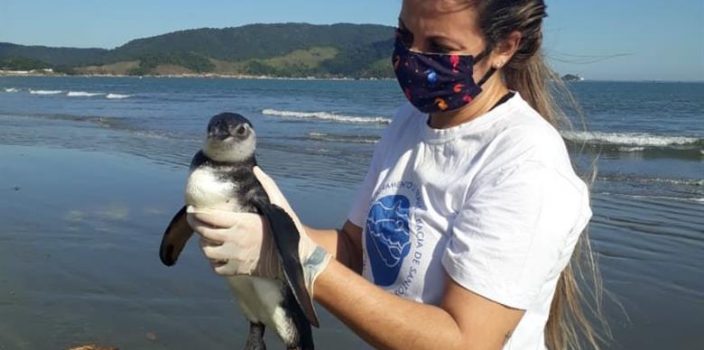RIO DE JANEIRO, BRAZIL – Brazil has begun to welcome the first of the Magellanic penguin species (Spheniscus magellanicus), from the Falkland Islands, Argentina and Chile, which annually migrate to the Brazilian coast in a season that usually runs from June to October. Peak season typically occurs between July and August.

The Santos Basin Beach Monitoring Project (PMP-BS), introduced by Petrobras in the region in 2015, rescued 9 penguins between Santa Catarina and São Paulo from late May to June 10, 4 of which on the São Paulo coast and 5 on the Santa Catarina beaches. The first one was found at Praia dos Ingleses, in Florianópolis (SC), on May 21. He was weakened, with dehydration and hypothermia symptoms, and was sent to the Rehabilitation Center.
Marine biologist André Barreto, coordinator of the PMP-BS in the SC/PR area, explains that penguins usually come from breeding colonies in Argentina, in colder waters and begin to spread out in search of food this time of year. “And part of the population eventually ends up here, in Brazil. That’s why we see more animals in the southern regions. Some reach Rio de Janeiro and we have records even in the Northeast, in Bahia. But it is less common. Rio Grande do Sul and Santa Catarina usually see more animals.”
Barreto explained that Magellanic penguins usually build colonies in South America, particularly on the Patagonian coast, where the largest colonies are located, and spread out in the South Atlantic. This species does not live on ice, like the emperor and king penguins. “This is a land-based penguin. Its colonies are on South American beaches.”
The animals reaching the Brazilian coast are weakened, in their great majority, or even dead, because their food supply chain is mostly in Argentina and Uruguay. “So the ones that get here are at the limit of their food supply. They can’t find their usual food anymore. They tend to get here more weakened.” The marine biologist lamented that only 10% of the animals rescued by the PMP are found alive.
With the PMP-BS active, these animals can be treated. “We are able to recover and return several of them to nature.” The PMP-Santos Basin extends from Rio de Janeiro to Santa Catarina. There are several bases in this area providing veterinary care for these animals. Dead animals are necropsied in an attempt to identify the cause of death. In Santa Catarina, the program includes five bases, one of which is a longer term rehabilitation center. When reaching the beaches, the weakest animals are taken to a stability unit, a kind of emergency room, where they remain for two or three days until their conditions improve somewhat and are then transferred to the center located in Florianópolis, where they recover.
André Barreto pointed out that penguins often enter their moulting period while in recovery, because these animals change their feathers once a year. If this occurs while they are still in recovery, the teams need to stay with them for another two to three months until the new feathers grow, because only then will they be able to swim back home. This is also important because it has been found that their survival chances are higher when they are returned in groups. “These animals form natural groups. So we have found that their chances of recovery are higher when they are released together.”
The penguins are returned to the sea according to each one’s health condition. The PMP only keeps animals when they are moulting, André Barreto explained. “Because then there is no point in releasing them back into their environment because they won’t be able to swim. They lose their impermeability. So, we have to wait for them to recover and grow new feathers before we can release them back into the wild.”
The PMP’s goal is to assess the impact of human activity on marine wildlife by monitoring beaches, André Barreto said.
In 2020, a year considered different from normal by the PMP-BS coordinator, 5,021 animals were recorded between June and October. In June alone, there were 2,700. In 2019, in the same season, there were 4,100 penguins, of which only 76 in June. “This is related to environmental variables, it could be the current, it could be wind, it could be the time they leave the colonies in Argentina. There are many factors involved here. The record year was 2018, when the season registered 11,900 penguins found on the coast. The bases were crowded. We struggled to collect that many animals from the beaches. So, each year is a surprise for us.”
Barreto stressed that, on average, 90% of penguins reach the Brazilian coast either dead or very weak and eventually die. Therefore, he emphasized the importance of regular and continuous beach monitoring in order to monitor environmental changes and determine if any impact is occurring. The penguins that reach the beaches with no need for rehabilitation are not caught. They return to the sea on their own, with no issues.
Before being returned to the sea, these animals are implanted a microchip under the skin, between the shoulder blades, on their backs. This microchip enables monitoring and recognizing these animals, should they return to the Brazilian coast.
Structured and implemented by Petrobras to meet federal environmental licensing requirements, the PMP is the world’s largest beach monitoring program.
The company currently runs four PMPs which together operate in 10 coastal states, monitoring over 3,000 kilometers of beaches. The PMP of the Santos Basin (PMP-BS) is the company’s most recent and is present in the South and Southeast, from Laguna (SC) to Saquarema (RJ).
Monitoring is conducted by the Brazilian Institute for the Environment and Renewable Natural Resources (IBAMA) and includes the registration, rescue, necropsy, rehabilitation, and release of mammals, turtles, and marine birds, contributing to the management of public policies for the conservation of marine biodiversity. The PMPs work in partnership with several scientific organizations and with local communities.

